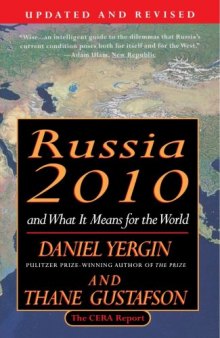دانلود کتاب Russia 2010 and What It Means for the World
by Daniel Yergin, Thane Gustafson|
|
عنوان فارسی: روسیه 2010 و آنچه در آن برای جهان معنی |
 دانلود کتاب
دانلود کتاب
 جزییات کتاب
جزییات کتاب
Most importantely, what Yergin and Gustafson did in "Russia 2010" was NOT to make absolute forecasts or to simply (and mindlessly) extrapolate from the situation at the time, but instead to apply powerful "scenario planning" techniques to thinking through the most likely futures for Russia. Back in 1993, the authors laid out four main scenarios: 1) "muddling down;" 2) the "Two-Headed Eagle;" 3) "Time of Troubles;" and 4) "Chudo" (economic miracle). How did the authors do?
Today, in 2004, we can confidently conclude that #4 was wrong -- there has been no Russian economic miracle, although oil prices have certainly helped Russia recover from the post-Soviet low point of the early- to mid-1990s. It also turns out that #1, "muddling down," the scenario that came closest to simply extrapolating from the existing situation at the time (as most forecasters erroneously do) was somewhat off the mark in the long run, although its predictions of a "relatively free atmosphere" and "weak Russian central government" did hold true for a few years at least. Scenario #3 is interesting, as it accurately anticipates separatist tendencies (although not specifically mentioning Chechnya) and the reaction of the "Russian Bear" to reassert itself. To some extent, that's exactly what we see today.
It is Scenario #4 (the "Two-Headed Eagle"), however, that appears to have hit the nail squarely - almost eerily so -- on the head. In "Russia 2010," Yergin and Gustafson posit that an attempted assassination on the Russian President by a "petty hoodlum"/mafia type "from the north Caucasus" leads to: a) Russian military action in that unnamed north Caucasus republic; b) a popular call for a crackdown on "the mafia, on corruption, and the private economy, which are all rolled into one in many people's minds;" c) the central government taking advantage of this situation to consolidate its own power, rein in the provinces, strengthen the executive over the legislative branch, reassert its control over natural resource exports; and d) an "ambivalent" and half-hearted Western reaction to these moves. Sound familiar? It should, because Scenario #4 -- the "premature reconstitution of a strong state" -- is almost exactly what we're seeing right now in Russia.
What Yergin and Gustafson have done, among other things, is to have demonstrated the tremendous value of "scenario planning" -- rigorously thinking through possible future paths as opposed to mindlessly extrapolating from the present. Although the latter course of action may be the easier (and lazier) way of trying to predict the future, it is also the least helpful and least accurate. Why would we think the future would be just like the present and recent past? The simple answer? Failure of imagination, and the lack of courage to go out on a limb and stand out from the herd. As Yergin and Gustafson point out, the normal "extrapolate from the current situation" forecasting methodology failed us miserably during the past few decades, missing most of the major turning points of those years. For instance, just about nobody managed to predict the Iranian Revolution, the collapse of the Soviet Union, the rise of Al Qaeda, 9/11, the course of oil prices from 1973 to now, or just about anything else during that period. Yergin and Gustafson, however, by spending some time and effort to actually think through possible scenarios, hit the nail on the head regarding the future of Russia in one of their four posited "scenarios" -- with two of the three others having large elements of truth as well. True, it's not 2010 yet, but as of September 2004, Yergin and Gustafson are looking pretty darned smart!





 این کتاب رو مطالعه کردید؟ نظر شما چیست؟
این کتاب رو مطالعه کردید؟ نظر شما چیست؟
